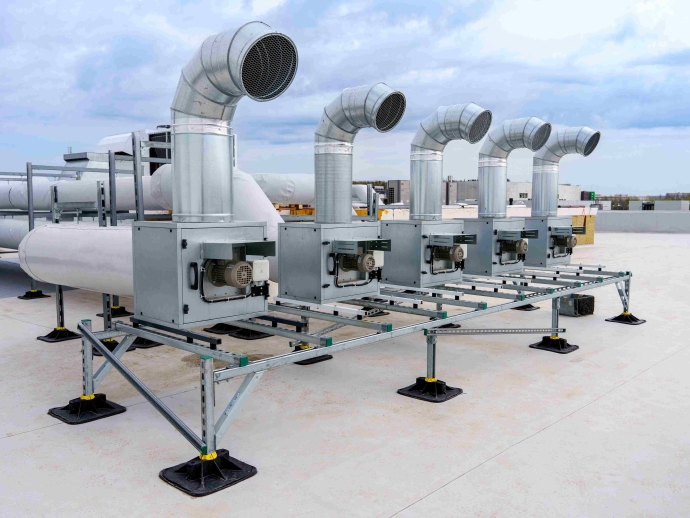Combining VRF and DOAS: The Perfect Marriage for Modern Commercial Buildings

In the quest for energy efficiency, improved indoor air quality (IAQ), and enhanced comfort, modern commercial buildings are increasingly turning to innovative HVAC solutions. Among these, the combination of Variable Refrigerant Flow (VRF) systems and Dedicated Outdoor Air Systems (DOAS) stands out as a particularly effective and synergistic approach. This article explores the benefits of integrating VRF and DOAS, highlighting how this "perfect marriage" can optimize building performance and create healthier, more comfortable environments.
Understanding VRF Systems
Variable Refrigerant Flow (VRF) technology is a multi-split type air conditioning system for commercial buildings that uses variable refrigerant flow control. Developed by Daikin, VRF systems provide individual zone control, allowing occupants to maintain different temperatures in various rooms or areas of a building. This precise control, coupled with inverter technology, minimizes energy consumption and delivers optimal energy savings.
VRF systems consist of an outdoor unit connected to multiple indoor units, each independently controlling refrigerant flow to meet specific heating or cooling demands. These systems are known for their high efficiency, utilizing variable speed compressors and fans to adjust output based on real-time requirements. VRF systems can also be arranged to provide heat recovery, moving heat from zones requiring constant cooling to zones that need heating, further enhancing energy efficiency.
Understanding DOAS Systems
A Dedicated Outdoor Air System (DOAS) is an air-handling unit dedicated to ventilation3. Unlike traditional HVAC systems that mix outside air with recirculated air, a DOAS delivers 100% outdoor air to the building. This separation of ventilation and conditioning allows for more precise control over IAQ, ensuring that occupants receive a constant supply of fresh, filtered air.
In its simplest form, a DOAS is a supply-only system with relief to the outdoors; however, it can also include exhaust heat recovery. Energy recovery systems use exhaust air to precondition incoming outdoor air, reducing ventilation loads by up to 80%. This is typically achieved through heat exchangers that provide sensible and latent energy exchange.
The Synergy of VRF and DOAS
While VRF systems excel at providing efficient heating and cooling, they are not designed to handle ventilation. This is where DOAS comes in, creating a synergistic relationship that maximizes the benefits of both systems. By separating the goal of achieving ventilation rates from that of maximizing thermal comfort, conflicting situations are avoided, simplifying the design process and improving system efficiencies.
The combination of VRF and DOAS offers several key advantages:
-
Improved Indoor Air Quality:
-
A DOAS delivers a constant supply of fresh, filtered outdoor air, which is essential for maintaining healthy IAQ.
-
By minimizing the recirculation of indoor air, DOAS reduces the concentration of pollutants, allergens, and other contaminants, creating a healthier environment for occupants.
-
-
Enhanced Energy Efficiency:
-
VRF systems provide precise temperature control and heat recovery capabilities, minimizing energy consumption for heating and cooling.
-
DOAS reduces the load on the VRF system by preconditioning outdoor air, further enhancing overall energy efficiency.
-
-
Simplified System Design:
-
Separating ventilation and conditioning simplifies the design process, allowing engineers to optimize each system for its specific purpose.
-
This modular approach provides flexibility and scalability, making it easier to adapt to changing building needs.
-
-
Increased Comfort:
-
VRF systems enable individual climate control settings for each zone, providing the utmost in comfort to commercial building settings.
-
DOAS ensures a consistent supply of fresh air, preventing stuffiness and improving overall occupant satisfaction.
-
-
Compliance with Standards:
-
The combination of VRF and DOAS helps commercial buildings meet stringent ventilation and energy efficiency standards.
-
DOAS with energy recovery can meet code requirements for energy recovery, while VRF systems contribute to overall energy performance.
-
Practical Applications
The VRF and DOAS combination is suitable for a wide range of commercial buildings, including offices, schools, healthcare facilities, and retail spaces. In office buildings, VRF systems can provide individual temperature control for different departments or zones, while DOAS ensures a constant supply of fresh air for all occupants. In schools, this combination can improve IAQ and create a more comfortable learning environment for students and teachers.
Conclusion
The integration of VRF and DOAS represents a significant advancement in HVAC technology for modern commercial buildings. By combining the strengths of both systems, building owners and operators can achieve superior energy efficiency, improved indoor air quality, and enhanced comfort. As the demand for sustainable and healthy buildings continues to grow, the "perfect marriage" of VRF and DOAS is poised to become the standard for HVAC design in the years to come.

